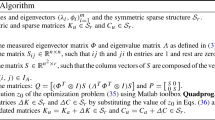Abstract
Quadratic eigenvalue model updating problem, which aims to match observed spectral information with some feasibility constraints, arises in many engineering areas. In this paper, we consider a damped gyroscopic model updating problem (GMUP) of constructing five n-by-n real matrices M,C,K,G and N, such that they are closest to the given matrices and the quadratic pencil Q(λ):=λ 2 M+λ(C+G)+K+N possess the measured partial eigendata. In practice, M,C and K, represent the mass, damping and stiffness matrices, are symmetric (with M and K positive definite), G and N, represent the gyroscopic and circulatory matrices, are skew-symmetric. Under mild assumptions, we show that the Lagrangian dual problem of GMUP can be solved by a quadratically convergent inexact smoothing Newton method. Numerical examples are given to show the high efficiency of our method.
Similar content being viewed by others
Notes
A pencil is called regular if there is at least one value of λ such that the determinant of Q(λ) is nonzero.
YAMLIP is a free MATLAB® toolbox to model and solve optimization problems. See details at http://users.isy.liu.se/johanl/yalmip/.
References
Bai Z, Chu D, Sun D (2007) A dual optimization approach to inverse quadratic eigenvalue problems with partial eigenstructure. SIAM J Sci Comput 29:2531–2561
Baruch M (1978) Optimization procedure to correct stiffness and flexibility matrices using vibration data. AIAA J 16:1208–1210
Bonnans J, Shaprio A (2000) Perturbation analysis of optimization problems. Springer, New York
Borwein J, Lewis A (1992) Partially finite convex programming, part ii: Explicit lattice models. Math Program 57:48–83
Brinkmeier M, Nackenhorst U (2008) An approach for large-scale gyroscopic eigenvalue problems with application to high-frequency response of rolling tires. Comput Mech 41:503–515
Carvalho J, Datta B, Lin W, Wang C (2006) Symmetry preserving eigenvalue embedding in finite-element model updating of vibrating structures. J Sound Vib 290:839–864
Chan Z, Sun D (2008) Constraint nondegeneracy, strong regularity and nonsingularity in semidefinite programming. SIAM J Optim 19:370–396
Chu D, Chu M, Lin W (2009) Quadratic model updating with symmetric, positive definiteness, and no spill-over. SIAM J Matrix Anal Appl 31:546–564
Chu M, Buono ND (2008) Total decoupling of a general quadratic pencil, part i: theory. J Sound Vib 309:96–111
Facchinei F, Pang JS (2003) Finite-dimensional variational inequalities and complementarity problems, vols I and II. Springer, New York
Friswell M, Inman D, Pilkey D (1998) The direct updating of damping and stiffness matrices. AIAA J 36:491–493
Friswell M, Mottershead J (1995) Finite element model updating in structural dynamics. Solid mechanics and its applications, vol 38. Kluwer, Dordrecht
Gao Y, Sun D (2009) Calibrating least squares semidefinite programming with equality and inequality constraints. SIAM J Matrix Anal Appl 31:1432–1457
Grant M, Boyd S (2011) CVX: Matlab software for disciplined convex programming, version 1.21. http://cvxr.com/cvx
Jia Z, Wei M (2011) A real-valued spectral decomposition of the undamped gyroscopic system with applications. SIAM J Matrix Anal Appl 32:584–604
Kuo Y, Lin W, Xu S (2006) New methods for finite element model updating problems. AIAA J 44:1310–1316
Lancaster P (1999) Strongly stable gyroscopic systems. Electron J Linear Algebra 5:53–66
Lancaster P (2008) Model-updating for self-adjoint quadratic eigenvalue problems. Linear Algebra Appl 428:2778–2790
Lin M, Dong B, Chu M (2010) Semi-definite programming techniques for structured quadratic inverse eigenvalue problems. Numer Algorithms 53:419–437
Löwner K (1934) Über monotone Matrixfunktionen. Math Z 38:177–216
Mottershead J, Friswell M (1993) Model updating in structural dynamics: A survey. J Sound Vib 167:347–375
Qian J, Lin W (2007) A numerical method for quadratic eigenvalue problems of gyroscopic systems. J Sound Vib 306:284–296
Rockafellar R (1974) Conjugate duality and optimization. SIAM, Philadelphia
Sturm J (1999) Using sedumi 1.02, a matlab toolbox for optimization over symmetric cones. Optim Methods Softw 11:625–633
Sun J, Sun D, Qi L (2004) A squared smoothing Newton method for nonsmooth matrix equations and its applications in semidefinite optimization problems. SIAM J Optim 14:783–806
Tisseur F, Meerbergen K (2001) The quadratic eigenvalue problem. SIAM Rev 43:235–286
Toh K, Tütüncü R, Todd M (2003) Solving semidefinite-quadratic-linear programs using SDPT3. Math Program 95:189–217
van der Vorst H (1992) Bi-CGStab: A fast and smoothly converging variant of BI-CG for the solution of nonsymmetric linear systems. SIAM J Sci Stat Comput 13:631–644
Wei F (1990) Mass and stiffness interaction effects in analytical model modification. AIAA J 28:1686–1688
Acknowledgement
The authors would like to thank the associate editor and the reviewers for their valuable comments.
Author information
Authors and Affiliations
Corresponding author
Additional information
X. Xiao was partially supported by the TianYuan Special Funds of the National Natural Science Foundation of China (Grant No. 11026166) and the Fundamental Research Funds for the Central Universities. L. Zhang was supported in part by the National Natural Science Foundation of China (grant No. 11071029) and the Fundamental Research Funds for the Central Universities.
Appendices
Appendix A: Basic duality theory
Let \(\mathcal{X}\) and \(\mathcal{Y}\) be two real Hilbert spaces, each equipped with a scalar product 〈⋅,⋅〉 and its induced norm ∥⋅∥. Let \(\mathcal{A}:\mathcal{X}\rightarrow\mathcal{Y}\) be a linear operator. Consider the following constrained best approximation problem,
where \(\mathcal{Q}\) is a closed convex cone in \(\mathcal{X}\). The Lagrangian dual (see, e.g., Borwein and Lewis 1992 or Bonnans and Shaprio 2000) of the best approximation problem (29) is in the form of
where \(\mathcal{A}^{*}:\mathcal{Y}\rightarrow\mathcal{X}\) is the adjoint of \(\mathcal{A}\), and for any \(x\in\mathcal{X}\), \(\varPi _{\mathcal{Q}}(x)\) is the metric projection of x onto \(\mathcal{Q}\); i.e., \(\varPi _{\mathcal{Q}}(x)\) is the unique optimal solution to
Define \(\theta:\mathcal{Y}\rightarrow\mathbb{R}\) by
Since \(\mathcal{Q}\) is a closed convex cone, the function θ takes the following form,
Note that θ(⋅) is a convex function (Borwein and Lewis 1992), and θ(⋅) is continuously differentiable (but not twice continuously differentiable) with
Then the dual problem (30) becomes a smooth convex optimization problem with a simple constraint:
In order to apply a dual based optimization approach to solve problem (29), we need the following generalized Slater condition to hold:
where “int” denotes the topological interior of a given set. The following proposition is a well known result in the conventional duality theory for convex programming (Rockafellar 1974, Theorems 17 and 18).
Proposition 2
Under the generalized Slater condition (33), there exists at least one \(y^{*}\in\mathcal{Y}\) that solves the dual problem (30), and the unique solution to original problem (29) is given by
Furthermore, for every real number τ, the level set \(\{y\in\mathcal {Y}:\theta(y)\leq\tau\}\) is closed, bounded, and convex.
From Proposition 2, one may use any gradient based optimization method to find an optimal solution to the convex optimization problem (30), and then to solve problem (29), as long as the generalized Slater condition (33) holds. Since \(\varPi _{\mathcal{Q}}(\cdot)\) is globally Lipschitz continuous, ∇θ(⋅) is globally Lipschitz continuous, which means one cannot use the classical Newton method to solve (30) directly. However, the semismooth Newton method or smoothing Newton method may be applicable if the function θ(⋅) is semismoothly differentiable.
Appendix B: Huber smoothing function
Suppose that the matrix \(X\in\mathcal{S}^{n}\) has the spectral decomposition
where λ 1≥⋯≥λ n are the eigenvalues of X and P is a corresponding orthogonal matrix of eigenvectors. Then,
Define three index sets
Write P=[P α P β P γ ] with P α ,P β and P γ containing the columns in P indexed by α,β and γ, respectively. Let ϕ:ℝ×ℝ→ℝ be the following Huber smoothing function:
For any ε∈ℝ, let
Note that ϕ(0,t)=max(0,t), and similarly \(\varPhi (0,X)=\varPi _{\mathcal{S}_{+}^{n}}(X)\). From Löwner (1934), we have that if β=∅ or ε≠0,
and
where “∘” denotes the Hadamard product, λ=(λ 1,…,λ n )T, and the matrix Ω(ε,λ) is given by
Thus if β=∅ or ε≠0, Φ(⋅,⋅) is continuously differentiable around \((\varepsilon,X)\in\mathbb{R}\times\mathcal {S}^{n}\). Furthermore, Φ(⋅,⋅) is globally Lipschitz continuous and strongly semismooth at any \((0,X)\in\mathbb{R}\times\mathcal{S}^{n}\), which can be easily proved as in Sun et al. (2004).
Appendix C: Proof of Proposition 1
Proof
It is easy to see that, if (Δε,ΔY,ΔZ)=0, E′(ε,Y,Z)(Δε,ΔY,ΔZ)=0. Thus we only need to show, E′(ε,Y,Z)(Δε,ΔY,ΔZ)=0 implies (Δε,ΔY,ΔZ)=0.
From the definition of E, E′(ε,Y,Z)(Δε,ΔY,ΔZ)=0 is equivalent to
which implies
where
Next, we consider

Since for any \(H\in\mathcal{S}^{n}\), both 〈H,H〉 and \(\langle H,\varPhi _{X}'(\varepsilon,X)(H)\rangle\) are nonnegative, we obtain
From N Δ =0, we get
Thus ΔZ=0 and ΔY=ΔY T. From C Δ =0, we get
Similarly, from G Δ =0, we have
Thus SΔY=0. Together with the fact that S=RΛR −1 is nonsingular, we obtain ΔY=0. The proof is complete. □
Rights and permissions
About this article
Cite this article
Xiao, X., Gu, J. & Zhang, L. Quadratic model updating with gyroscopic structure from partial eigendata. Optim Eng 14, 431–455 (2013). https://doi.org/10.1007/s11081-012-9188-0
Received:
Accepted:
Published:
Issue Date:
DOI: https://doi.org/10.1007/s11081-012-9188-0




